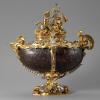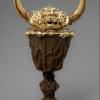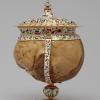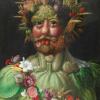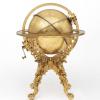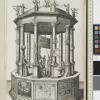Rudolf II by Hans von Aachen, 1606/8
External links
Commentary
Rudolf II of Habsburg (1552-1612) was one of the great art patrons and collectors of his day, or indeed of any other. As Holy Roman Emperor between 1576 and 1612, he occupied the supreme position within Europe's formal political hierarchy; and although that theoretical superiority could be questioned in practice there was no misdoubting his place at the very apex of the mania for collecting all manner of rare and unusual objects which peaked in the Empire during his lifetime.
Historiography. A mercurial and mysterious figure during his own day, Rudolf II long baffled historians due to his personification of three quite separate attributes: while art historians hailed him as one of the greatest patrons and collectors of all time, political historians condemned him as an ineffective and ultimately disastrous ruler, while intellectual historians classified him as a patron of occult arts such as astrology and alchemy. The first work to synthesise these three different personae into a coherent portrait was R.J.W. Evans's Rudolf II and His World: A Study in Intellectual History (Oxford, 1973, reissued with corrections in 1997). Hugh Trevor-Roper immediately made the core thesis of this profound but challenging work more readily accessible in his essay on ‘Rudolf in Prague’, Princes and Artists: Patronage and Ideology at Four Habsburg Courts, 1517-1633 (1976), 85-126. Another brief synopsis can be found in Howard Hotson's article on ‘Rudolf II’ in Encyclopedia of the Renaissance, ed. Paul F. Grendler, 6 vols., (1999), v. 372-4. Peter Forshaw, Howard Hotson, and Adam Mosley share introductory impressions in an episode of the BBC's In Our Time.
Further resources. Evans' book helped make Rudolfine Prague a major industry in its own right. Two major exhibition catalogues arising from this industry are Kulturstiftung Ruhr, Prag um 1600: Kunst und Kultur am Hofe Rudolfs II (2 vols, Freren/Emsland: Luca, 1988) and Eliška Fučíková (ed.), Rudolf II and Prague: The Court and the City (Prague: Prague Castle Administration; London: Thames and Hudson, 1997).
Museum resources. Rudolf's collection was widely dispersed during the Thirty Years' War, but many dazzling pieces from it can be seen together in the Kunstkammer at the Kunsthistorisches Museum in Vienna. A beautifully illustrated introduction to the broader dynastic collections within which these Rudolfine materials sit is Sabine Haag and Franz Kirchweger (eds.), Treasures of the Habsburgs: the Kunstkammer at the Kunsthistorisches Museum, Vienna (London: Thames & Hudson, 2013).
Other objects associated with Rudolf on Cabinet are collected in Related Sources.
Credits: Howard Hotson (May 2019)

